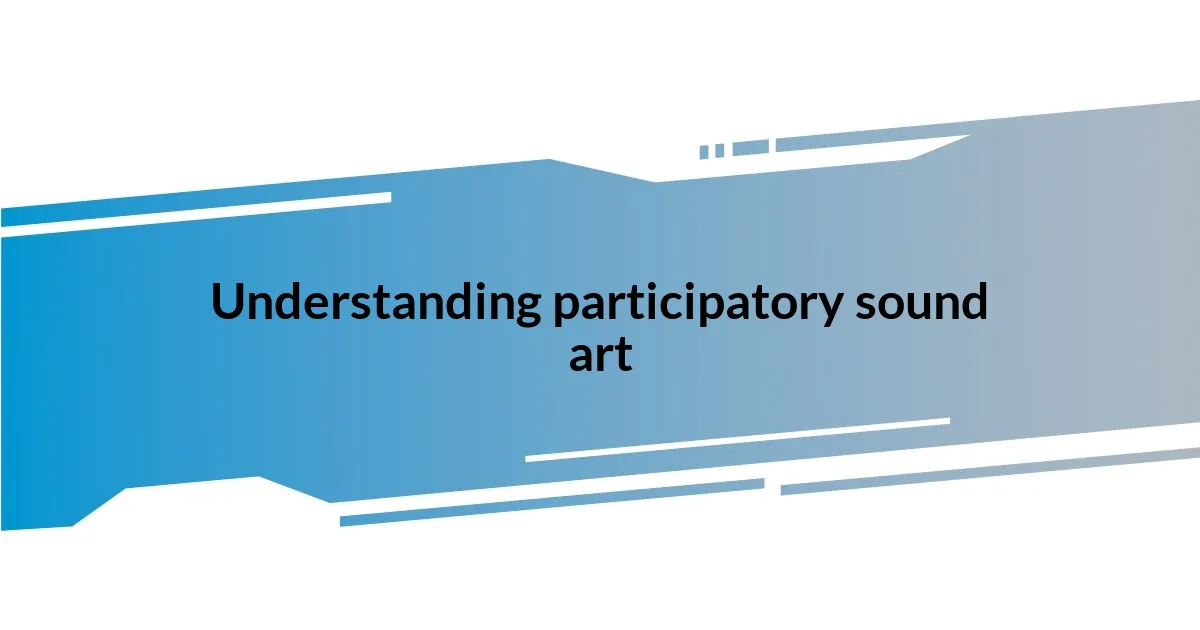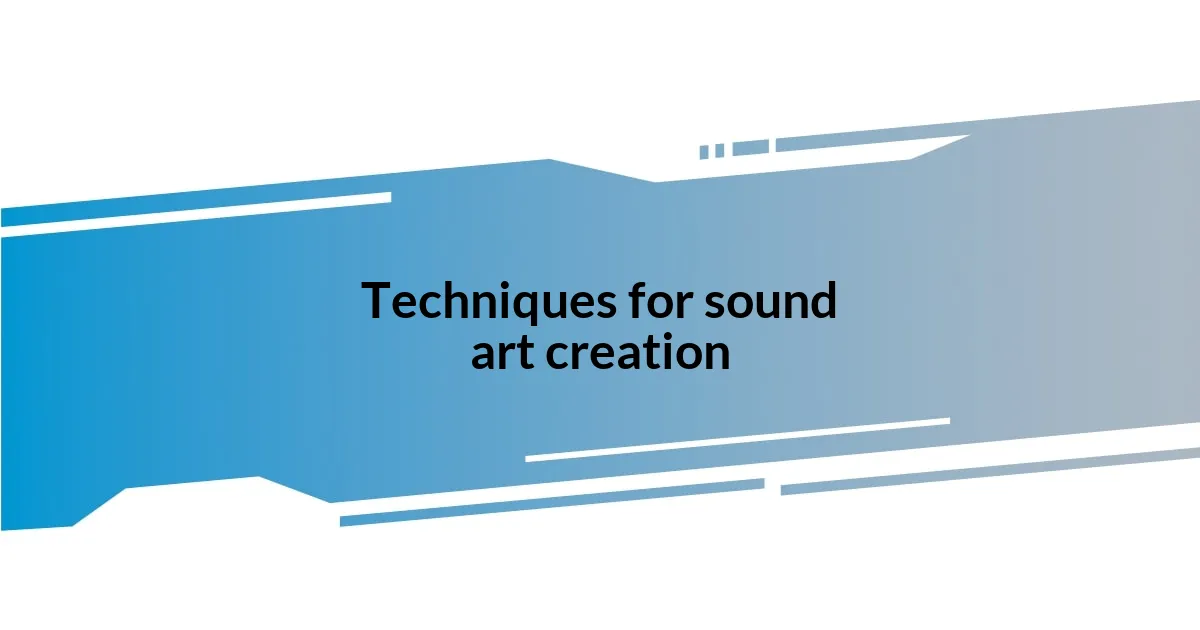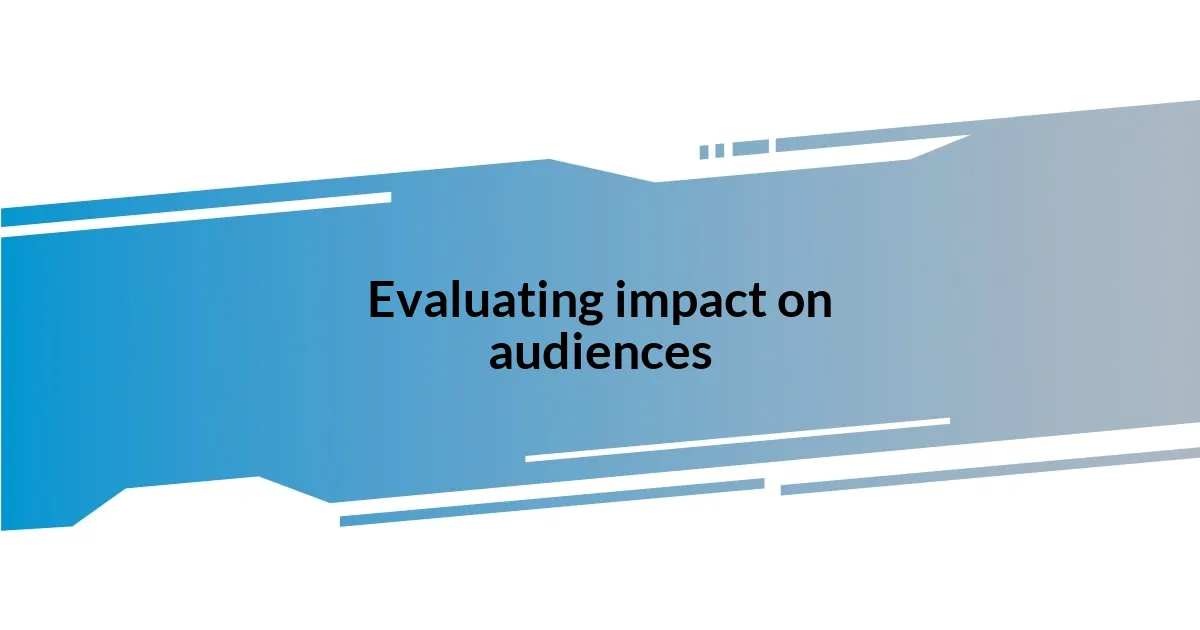Key takeaways:
- Participatory sound art transforms audience members into active creators, fostering community and connection through shared experiences.
- Engagement with diverse voices enriches sound art, allowing unique cultural narratives to intertwine, creating a tapestry of shared memories.
- Techniques like field recordings and interactive installations enhance participation, allowing individual contributions to shape collective soundscapes.
- Evaluating the impact reveals that participatory sound art evokes emotions, encouraging introspection and deepening connections within communities.

Understanding participatory sound art
Participatory sound art is a fascinating approach that goes beyond traditional listening. It invites the audience to become active creators, blurring the lines between artist and spectator. I remember immersing myself in a public sound installation where passersby were encouraged to contribute their own sounds; it transformed a mundane street corner into a dynamic soundscape filled with laughter, chatter, and unexpected noise.
What captivates me most about participatory sound art is its ability to foster community and connection. It creates a shared experience where diverse voices merge into a collective sound. Have you ever found yourself in a space where everyone’s contributions resonated with your own emotions? I did, during a community workshop where we recorded stories from our lives; it made me realize how deeply our individual experiences can intertwine.
This art form also challenges our conventional understanding of sound. Rather than being just an auditory experience, it encourages reflection on our surroundings and interactions. For instance, in one project I engaged with, the sound environment changed based on how many people participated, reminding us that our choices and engagement can shape the collective atmosphere. Isn’t it intriguing to think we have that power?

Importance of community engagement
Engaging the community in participatory sound art is crucial, as it cultivates a sense of belonging and ownership. I recall an outdoor sound project where local musicians collaborated with residents to create a symphony of shared memories. This involvement transformed our neighborhood’s identity, allowing us to express who we are and what we value collectively.
Moreover, the participation of diverse voices enriches the artwork, introducing unique perspectives and layering cultural narratives. I once took part in a neighborhood sound workshop where each participant brought their own cultural background into the recordings. It was eye-opening to witness how different backgrounds could harmonize, creating a beautiful tapestry of sound that told the story of our community. Have you ever felt that thrill when various stories come together in one shared moment? It’s powerful.
When community members engage in the artistic process, the resulting work reflects a more authentic and relatable experience. I remember sitting in a circle, sharing sounds from our daily lives, and realizing how much the simple act of participation could transform personal anecdotes into something universal. Each echo became a connection, bridging gaps and fostering understanding in a way that is truly special.
| Aspect | Importance of Community Engagement |
|---|---|
| Sense of Belonging | Fosters community identity and personal connection. |
| Diverse Perspectives | Enriches the artwork through unique narratives. |
| Authenticity | Creates relatable experiences that resonate with the audience. |

Techniques for sound art creation
Creating sound art is an intriguing blend of traditional techniques and innovative approaches that invite active participation. I find that one of the most enjoyable methods is using field recordings, where artists capture sounds from their environments—be it a bustling market, a serene park, or even the hum of a busy café. This technique not only showcases the unique auditory tapestry of a place but also invites contributors to reflect on their personal experiences related to those sounds. I remember recording the gentle rustle of leaves while walking in a local park; it was a simple act, yet hearing it layered with voices later was transformative.
Here are some effective techniques for engaging in sound art creation:
- Field Recordings: Capturing natural sounds to incorporate into the work.
- Loop Pedals: Allowing artists to layer sounds live, creating complex soundscapes on the spot.
- Collaborative Workshops: Bringing community members together to explore sound, fostering creativity and shared experiences.
- Interactive Installations: Designing spaces where audience participation directly influences the sound output, creating a dynamic environment.
Each of these techniques plays a crucial role in enhancing the participatory aspect of sound art. Engaging with them not only amplifies individual voices but also allows for the creation of a rich, communal sound narrative. I remember when I joined a group using loop pedals; each person’s contributions blended into a remarkable tapestry of sound, echoing our shared creativity. It became clear to me that the process of creation itself was as valuable as the final piece.

Tools for enhancing sound experiences
Exploring tools for enhancing sound experiences adds depth to participatory sound art. One tool I’ve come to appreciate is the use of smartphone apps for sound manipulation. They empower people to create and modify soundscapes on the go. I remember recording my morning commute with an app that allowed me to add effects like echoes and delays. Listening back, I was surprised at how those simple alterations transformed an ordinary experience into an intriguing auditory journey. Isn’t it fascinating how technology can further our creativity?
Another fascinating tool is the use of contact microphones, which allows artists to capture vibrations directly from surfaces. When I experimented with these microphones on different objects—like a wooden table or a piece of metal—it unveiled a whole new world of sounds that I never noticed before. It made me wonder: what hidden sounds are waiting to be discovered in our daily surroundings? This simple tool opened my ears to the richness of textures around us, inspiring new layers in collaborative projects.
Interactive sound installations are another exciting avenue to explore. These setups let audiences participate by altering sound in real-time, making each visit a unique experience. I participated in one such installation where walking past certain sensors would trigger different sound samples. The thrill of seeing people’s reactions—some laughing, others lost in thought—was truly rewarding. It showed me the powerful bond formed when people engage directly with sound art. How often do we have the chance to actively shape our surroundings instead of just observing? These moments really drive home the essence of participatory sound experiences.

Evaluating impact on audiences
When evaluating the impact of participatory sound art on audiences, it becomes clear that the experience can be deeply personal and transformative. I still remember the first time I engaged with an interactive sound installation. As I stepped closer, I felt an immediate connection—not just to the sounds but to the people around me. There’s something magical about sharing an experience where every person’s action shapes the auditory environment, isn’t there? This interplay fosters a sense of community that resonates well beyond the exhibition.
Moreover, how audiences respond to these installations speaks volumes about their impact. I’ve noticed that when people are invited to participate, their body language changes; they become more open, expressive, even playful. For instance, during a community event, I saw a child literally jump up in delight as they activated sounds that resonated with their laughter, merging their joy with the art itself. It’s profound to witness how sound art bridges generational gaps and creates shared moments and memories.
I believe the real success of participatory sound art lies in its ability to evoke emotions and provoke thoughts. I’ve often left these installations with more than just auditory impressions; they linger in my mind like echoes, prompting introspection about our relationships with sound and each other. What does it mean to share silence or noise in a communal space? Such questions enrich our understanding of sound art’s role, leading to deeper connections that extend beyond the auditory into the very fabric of human experience.